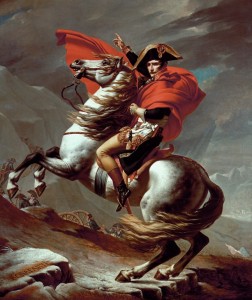Marengo: Napoleon’s Horse November 15, 2011
Author: Beach Combing | in : Modern , trackbackNapoleon had a great fondness for horses, he was often painted in the saddle and Hegel went so far as to call the Corsican general ‘the worldspirit on horseback’. But Marengo, Napoleon’s favourite steed, must go down in history as one of the unluckiest horses that ever lived. Allegedly purchased by his diminutive master in the Egyptian campaign of 1799, Marengo was subsequently ridden to Moscow and back, distances that took him in the space of a campaigning season what most horses will not cover in a lifetime. And he was ridden there badly for ‘Napoleon rode’ noted one observer, ‘like a butcher… his body rolling backwards and forwards and sideways, according to the speed of his horse.’ Indeed, one can almost see poor Marengo, a fourteen-hand Arabian stallion, trying not to throw the ‘Emperor’ as he galloped away from Russian canons and the snow fell all around: how Marengo must have longed for the Nile then! After that there were the battles. We cannot be certain of all of the melees in which Napoleon rode his unlucky horse. But there is no doubt that Marengo fought, for in later life, a bullet was found lodged in his tail and five long scars were counted across his body. Then, in 1823 the final humiliation: a prize of war, Marengo was taken to the enemy capital London and paraded in front of the crowds, who had the impudence to point at and touch the branded ‘N’ on his flank. Nor was death to release Marengo from the English, who to this day imprison him, a grinning but doubtless resentful skeleton in the National Army Museum. The French, who insist on showing another of Napoleon’s horses, Le Vizir, at the Musée de l’Armée, at least had the decency to stuff their ‘exhibit’.
Beachcombing should note that Marengo is probably the only horse ever to have been honoured with a biography: Jill Hamilton’s Marengo: The Myth of Napoleon’s Horse (Fourth Estate 2000). For the most part she covers questions of identity in paintings etc that would weigh down this brief post. However, it is well worth a read.
Any more preeminent horses? drbeachcombing AT yahoo DOT com
***
18 Nov 2011: Southern Man wants a post on Mr Ed and Champion the Wonder Horse. KMH writes ‘The obvious answer to your question is Bucephalus,the famous horse of Alexander, who, I believe unlike Napoleon, never lost a battle. The greatest conquerer rides the best horse, a notion that the modern mind may find all too self-serving.’ Tim, meanwhile, writes: Regards famous horses you would have to put Bucephalus up there. And here in the states, Robert E. Lee’s horse, Traveler.’ Invisible references an unusual book on horses: Judith from Zenobia writes in with tongue firmly in cheek: Marengo may also be the only horse to have been honoured by an imperial recipe: Chicken Marengo (now, more often, Veal Marengo), first prepared by Napoleon’s Master-chef. The story is given in the Larousse Gastonomique. I’m only kidding, of course. The dish – and the horse – are both named after the battle. On the other hand, if the horse were bought and named in 1799 and the battle only took place in 1800, perhaps, after all, there’s something in my version :-)’ Woops. Perhaps the battle was named after the horse or the chicken dish? Thanks Judith, Southern Man, Invisible and KMH!



